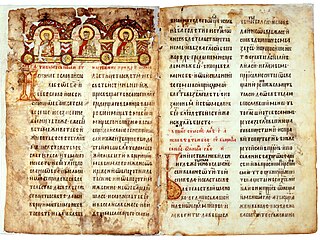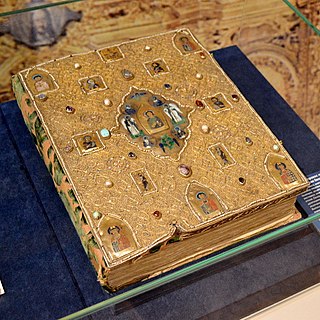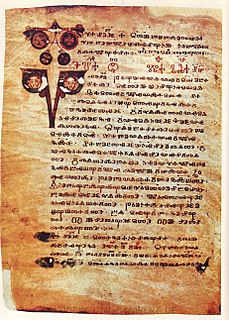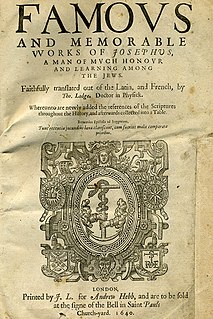 W
WCyril and Methodius (815–885) were two brothers and Byzantine Christian theologians and missionaries. For their work evangelizing the Slavs, they are known as the "Apostles to the Slavs".
 W
WThe Archangelsk Gospel is a lectionary in Old Church Slavonic dated to 1092. It is the fourth oldest Eastern Slavic manuscript. The book is stored in the collection of the Russian State Library. UNESCO added the Arkhangelsk Gospel to the international register Memory of the World Programme in 1997.
 W
W W
WThe Codex Marianus is an Old Church Slavonic fourfold Gospel Book written in Glagolitic script, dated to the beginning of the 11th century, which is, one of the oldest manuscript witnesses to the Old Church Slavonic language, one of the two fourfold gospels being part of the Old Church Slavonic canon.
 W
WThe Codex Suprasliensis is a 10th-century Cyrillic literary monument, the largest extant Old Church Slavonic canon manuscript and the oldest Slavic literary work in Poland. As of September 20, 2007, it is on UNESCO's Memory of the World list.
 W
WCyrillic numerals are a numeral system derived from the Cyrillic script, developed in the First Bulgarian Empire in the late 10th century. It was used in the First Bulgarian Empire and by South and East Slavic peoples. The system was used in Russia as late as the early 18th century, when Peter the Great replaced it with Arabic numerals as part of his civil script reform initiative. Cyrillic numbers played a role in Peter the Great's currency reform plans, too, with silver wire kopecks issued after 1696 and mechanically minted coins issued between 1700 and 1722 inscribed with the date using Cyrillic numerals. By 1725, Russian Imperial coins had transitioned to Arabic numerals. The Cyrillic numerals may still be found in books written in the Church Slavonic language.
 W
WThe Enina Apostle or Enina Apostolos is an 11th-century Old Church Slavonic Cyrillic manuscript. Discovered in a poor condition in 1960 during restoration work in the central Bulgarian village of Enina, the partially preserved parchment manuscript is housed in the SS. Cyril and Methodius National Library in Sofia. It is the oldest Cyrillic manuscript currently held by any Bulgarian collection.
 W
WThe Euchologium Sinaiticum is a 109-folio Glagolitic Canon of Old Church Slavonic euchologion. It contains parts of the liturgy of the St. John Chrysostom, and is dated to the 11th century.
 W
WThe First Romanian School is located on the grounds of the 16th-century church of St. Nicholas, itself located in the historic district of Șcheii Brașovului, in what is now Brașov, Romania. This is the first school in the territory of present-day Romania where Romanian language was used in teaching.
 W
WThe Glagolita Clozianus is a 14-folio Glagolitic Old Church Slavonic canon miscellany, written in the eleventh century.
 W
WGlagolitic numerals are a numeral system derived from the Glagolitic script, generally agreed to have been created in the 9th century by Saint Cyril. They are similar to Cyrillic numerals, except that numeric values are assigned according to the native alphabetic order of the Glagolitic alphabet. Use of Glagolitic script and numerals declined through the Middle Ages and by the 17th century Glagolitic was used almost only in religious writings. It is unclear if the use of Glagolitic numerals persisted as long as the use of Glagolitic script.
 W
WThe Kiev Missal is a seven-folio Glagolitic Old Church Slavonic canon manuscript containing parts of the Roman-rite liturgy. It is usually held to be the oldest and the most archaic Old Church Slavonic manuscript, and is dated at no later than the latter half of the 10th century. Seven parchment folios have been preserved in small format of easily portable book to be of use to missionaries on the move.
 W
WLouis Léger (1843–1923) was a French writer and pioneer in Slavic studies. He was honorary member of Bulgarian Literary Society (now Bulgarian Academy of Sciences, also member of Académie des inscriptions et belles-lettres in Paris. Academic institutions in Saint-Petersburg, Belgrade and Bucharest had given him a different status of membership.
 W
WThe medieval Bulgarian royal charters are some of the few surviving secular documents of the Second Bulgarian Empire, and were issued by five tsars roughly between 1230 and 1380. The charters are written in Middle Bulgarian using the Early Cyrillic alphabet.
 W
WMiroslav's Gospel is a 362-page illuminated manuscript Gospel Book on parchment with very rich decorations. It is one of the oldest surviving documents written in the Serbian recension of Church Slavonic. The gospel is considered a masterpiece of illustration and calligraphy.
 W
WThe Archbishopric of Moravia was an ecclesiastical province, established by the Holy See to promote Christian missions among the Slavic peoples. Its first archbishop, the Byzantine Methodius, persuaded Pope John VIII to sanction the use of Old Church Slavonic in liturgy. Methodius had been consecrated archbishop of Pannonia by Pope Adrian II at the request of Koceľ, the Slavic ruler of Pannonia in East Francia in 870.
 W
WMstislav Gospel is a 12th-century manuscript of the four Gospels on parchment in Old Church Slavonic. It is kept in the State Historical Museum in Moscow. The manuscript contains the text of the four Gospels on 213 parchment leaves.
 W
WThe Ohrid Literary School or Ohrid-Devol Literary school was one of the two major cultural centres of the First Bulgarian Empire, along with the Preslav Literary School. The school was established in Ohrid. Another center was Devol as well as Drembica, Glavinica and Velika with unknown location. All the school centers were located in a then province known as Kutmichevitsa. It was founded in 886 by Saint Clement of Ohrid on the order of Boris I of Bulgaria simultaneously or shortly after the establishment of the Preslav Literary School. After Clement was ordained bishop of Drembica, Velika (bishopric) in 893, the position of head of the school was assumed by Naum of Preslav. The Ohrid Literary School used the Glagolitic alphabet from its establishment until the 12th century and Cyrillic from the end of the 9th century onward. Between 990 and 1015, Ohrid was the capital of the Bulgarian Empire and simultaneously also the seat of the Bulgarian Patriarchate.
 W
WThe Ostromir Gospels is the oldest dated East Slavic book.. The Ostromir Gospels was created by deacon Gregory for his patron, Posadnik Ostromir of Novgorod, in 1056 or 1057, probably as a gift for a monastery.
 W
WThe Psalterium Sinaiticum is a 209-folio Glagolitic Old Church Slavonic canon manuscript, the earliest Slavic psalter, dated to the 11th century. The manuscript was found in Saint Catherine's Monastery in Egypt, after which it was named and where it remains to this day.
 W
WReims Gospel is an illuminated manuscript of Slavonic (Slavic) origin which became part of the Reims Cathedral treasury. Henry III of France and several of his successors including Louis XIV took their oath on it. In the time of Charles IV, who gave it to the just-founded Emmaus monastery in Prague, the text was believed to have been written by the hand of St. Procopius.
 W
WSava's book is a 129-folio Cyrillic Old Church Slavonic canon evangeliary, written in the eleventh century.
 W
WThe Seven Saints or Seven Slavic Saints is a collective name for the famous creators and distributors of the Slavic writing and the Word of God (Bible) among the Slavs, and throughout Eastern Europe - Saints Cyril and Methodius; Saint Clement of Ohrid; Saint Naum; Saint Gorazd; Saint Sava and Saint Angelar.
 W
WThe Slavonic Josephus is an Old East Slavic translation of Flavius Josephus' History of the Jewish War which contains numerous interpolations and omissions that set it apart from all other known versions of Josephus' History. The authenticity of the interpolations was a major subject of controversy in the 20th century, but the latest scholarship has rejected them.
 W
WThe Temnić inscription is one of the oldest records of Old Church Slavonic Cyrillic script from the territory of Serbia. The limestone plate was discovered in the vicinity of a school in the village of Gornji Katun, near Varvarin, in the region of Temnić in Pomoravlje. It was acquired by the National Museum of Serbia in 1909. The tablet represents a scientific conundrum as no other remains of an edifice were found and paleographic and linguistic analysis of the text reveals little information.
 W
WThe Treatise Against the Bogomils is a polemical and didactic work of Old Bulgarian literature, written by Cosmas the Priest, a church writer close to Tsar Peter I of Bulgaria.
 W
WIn Slavic Christianity, the trilingual heresy or Pilatian heresy is the idea that Biblical Hebrew, Greek, and Latin are the only valid liturgical languages or languages in which one may praise God. Trilingualism was rejected in the 850s by Saints Cyril and Methodius, Byzantine brothers and missionaries who introduced a Christian liturgy in the vernacular of their Slavic converts, a language now called Old Church Slavonic.
 W
WVukan's Gospel is a 13th-century Serbian illuminated manuscript in Serbian recension of Church Slavonic. It is one of the oldest preserved Serbian medieval books, with more than 189 pages.